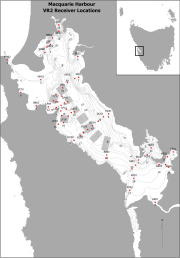ENDANGERED SPECIES
Type of resources
Topics
Keywords
Contact for the resource
Provided by
Years
-

This record provides an overview of the NESP Marine and Coastal Hub Research Plan 2023 project "Delineation and estimation of the Maugean skate population in Macquarie Harbour, Tasmania". For specific data outputs from this project, please see child records associated with this metadata. -------------------- The endangered Maugean skate is now only found in Macquarie Harbour, which has a long history of environmental degradation, and recent research suggests that the population may be declining. However, our current abundance estimation tools are inadequate to determine population status and a new method is needed. This project will use next generation genetic sequencing and novel imaging survey tools to delineate and estimate the size of the Macquarie Harbour Maugean skate population to inform conservation strategies. There is also a need to investigate the evolutionary potential of the Maugean skate to adapt to the changing environmental conditions. This research will address these needs by examining the skate's genetic diversity and fine-scale population structure using whole genome typing, and developing a high-resolution dataset of genome-wide single nucleotide polymorphisms. This genetic approach will help inform adaptive management strategies, such as captive breeding, and enhance our ability to detect differentiated lineages with adaptive potential. Outputs • Tissue sampling results and genome-wide population genetic structure [dataset] • Adaptive resolution imaging sonar (ARIS) and lidar water column scanning [dataset] • Final project report [written]
-

This record provides an overview of the NESP Marine and Coastal Hub small-scale study - "Conservation of spotted handfish". For specific data outputs from this project, please see child records associated with this metadata. -------------------- Spotted handfish are a critically endangered fish that inhabit a rapidly developing coast. This bridging project continues efforts to conserve the species with on-ground actions guided by research. Previous NESP work (A10) helped developed a 23-year time-series of surveys, increased biological understanding and established effective management actions. This new work will recommence surveys of multiple local populations, after a two-year gap, to ensure potential impacts of development of the Derwent estuary and surrounds handfish populations or their habitats can be detected. We will also identify where to plant Artificial Spawning Habitats (ASH) where natural spawning structures have declined. We will continue to support our captive breeding program with industry and foster engagement with the indigenous and broader community through participation, talks, outreach, publications, and the National Handfish Recovery Team (NHRT). Outputs • A consolidated database of all available data on spotted handfish imagery, length frequency, and GPS regions to 2022 [time-series database] • Final technical report with analysed data, including a short summary of recommendations for policy makers of key findings [written]
-

This record provides an overview of the NESP Marine and Coastal Hub emerging priorities study - "Application of environmental DNA to survey Bathurst Harbour Tasmania for the endangered Maugean skate". For specific data outputs from this project, please see child records associated with this metadata. -------------------- This study will use Environmental (e) DNA to determine the presence/absence of the endangered Maugean skate (Zearaja maugeana) in Bathurst Harbour, Tasmania. Zearaja maugeana is classified as endangered based on its small population (~ 3000 individuals, Macquarie Harbour, Tasmania, 2016) and restricted distribution (Bathurst and Macquarie Harbours). Initially discovered in Bathurst Harbour in 1988, it has not been recorded there since 1992. Additionally, recent research suggests that the Macquarie Harbour population may be declining. As such, there is an urgent need to determine the current status of the Bathurst Harbour population. This research will address this need. Outputs • Maugean skate eDNA sampling data and inferred species distribution (presence/absence) [dataset] • Final technical report with analysed data, including a short summary of recommendations for policy makers of key findings [written]
-

Fixed position oxygen and water temperature logger data from the Macquarie Harbour World Heritage Area (WHA). Two Hobo oxygen data loggers are positioned at approximately 15 m depth at different sites within the WHA, with the intent of monitoring representative mid-bottom water oxygen values in the WHA as these were identified in previous studies to be naturally low due to limited seawater exchange at the harbour entrance, and thus likely to be most susceptible to anthropogenic factors that may increase oxygen demand and alter WHA conservation values. These values include core habitat of the Maugean Skate, a listed threatened species. This work is funded by WHA advisory board via the Nature Conservation Branch of DPIPWE and is part of a larger study being conducted by IMAS undertaking a biological baseline study of the biodiversity of the Macquarie Harbour WHA. This data spans 08/11/14 to present (most recent update 02/02/17).
 IMAS Metadata Catalogue
IMAS Metadata Catalogue